1012
Polar Wolf closeup
Polar wolves - home cold and snow of the Arctic Circle.
30 photo + letter via animalpicture
1. Polar Wolf lives in the vast expanses of the polar regions, which are five months immersed in darkness. To survive, the wolf has adapted any food that comes only. It is well-adapted to life in the Arctic could live for years in sub-zero temperatures for months without seeing the sunlight for weeks and go without food.

2. The length of an adult wolf - 100 - 150 cm, height at the withers - 65-80 cm, weight - 80 kg.

3. Polar wolves live up to seven years.

4. Polar wolves inhabit one of the most barren areas of the Earth, where in April the temperature rarely rises above -30 ° C. (~ Blickwinkel ~)

5. The most numerous group of animals living in these parts - it lemmings and Arctic hare. However, in order to survive, a pack of wolves is sometimes necessary, and larger prey. (conwest_john)
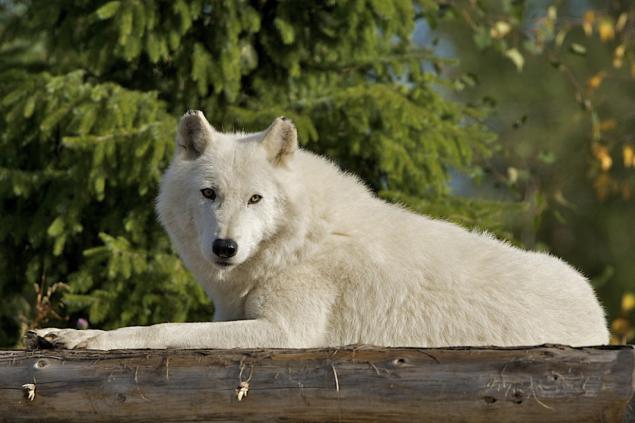
6. Such are musk oxen and reindeer, but they rarely come to these territories. Therefore, wolf pack should bypass an area covering 2,000 square kilometers. In winter the temperature drops. Small animals hide under the ground and caribou for food go to the south. Wolves follow them. (conwest_john)

7. At the open spaces of the tundra is difficult to find shelter for a surprise attack on the victim. (WhiteWolf35)

8. Polar wolves are kept in flocks of 7-10 individuals. The most common family pack, which consists of parents, their cubs and individuals from previous litters. (Kadacat (Marlene)

9. Pack, usually headed by the leader, and his female in the pack takes a similar position. The residue was subject to their flocks and forms its own hierarchy. (Anne Elliott)

10. The hierarchical relationships within the pack are carried out using complex language, consisting of movements, barking and growling. (conwest_john)

11. Wolves are holding a high position in the pack, subordinates require unquestioning obedience, they, in turn, expressing devotion humbly pressed to the ground or lie on your back. Severe, bloody clashes between wolves are rare. (Kadacat (Marlene)

12. Wolves howl to alert other flocks of his presence, so they mark territory and try to avoid the meeting, which would lead to a fight. (conwest_john)

13. Cry Wolf - is, as a rule, young animals, which have left their flock and went in search of a particular area. (conwest_john)

14. When a wolf is unoccupied territory it designates it by the urinary points or defecating in certain well-marked areas, stating your rights to it. (Michel Roy)

15. The period of mating polar wolves - from February to April. Gestation lasts 61 to 75 days. A young per litter is usually born 4-5. (alain tremblay)

16. In autumn and winter flock of migrating, but after the mating season, leaving her pregnant wolf to find a den. (conwest_john)

17. Sometimes, she digs wolf's den, but in winter, when the ground is frozen much, the female brings posterity in the old den in a rocky crevice or. (L. David Mech)
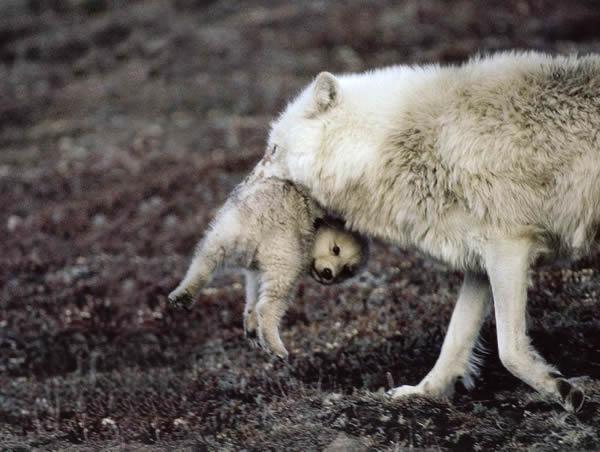
18. The cubs are born blind, with closed ear holes and absolutely helpless. They are totally dependent on the mother. (L. David Mech)
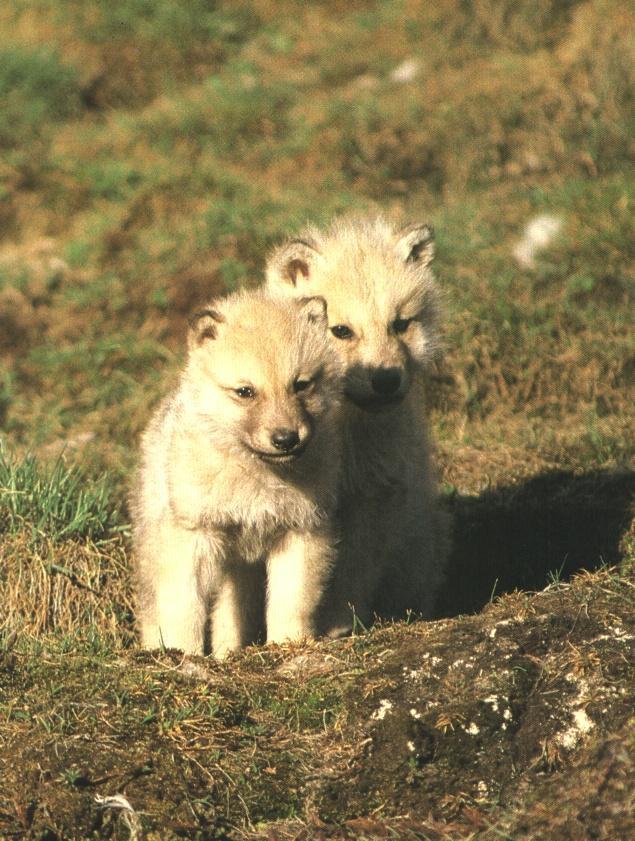
19. Approximately a month later the cubs already can eat half-digested meat, burp male who brings all this time the wolf cubs and food. If a lot of food, the young wolves from the beginning of the summer are full members of the flocks and migrate with adult individuals.

20. Only one in ten of the pack hunting is successful.
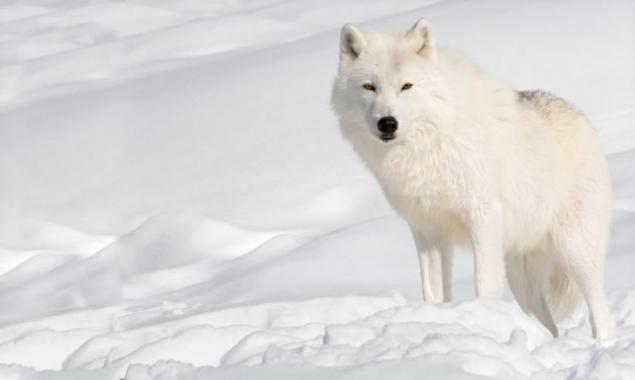
21. Sometimes the wolves for many days without food, but then eat 10 kg of meat at a time.

22. In the tundra so little food that the wolf, for example, eats arctic hare with skin, hair and bones.
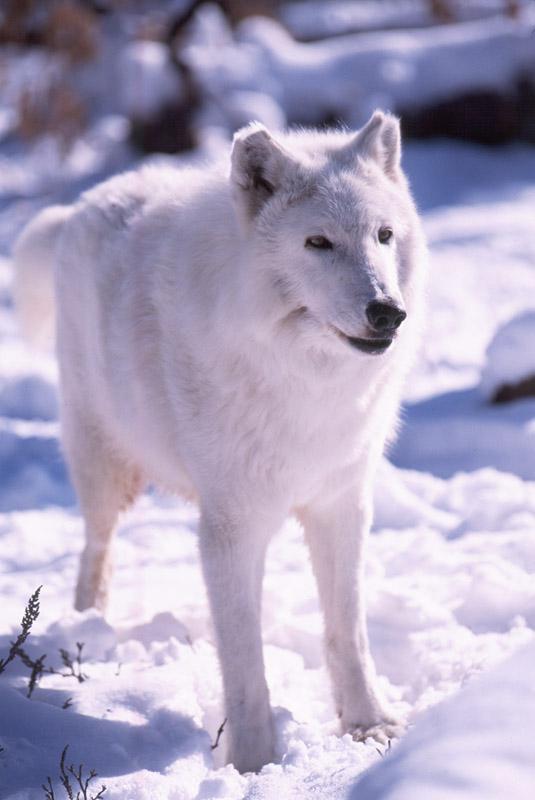
23. Wolves are mostly nocturnal. They have developed excellent hearing.
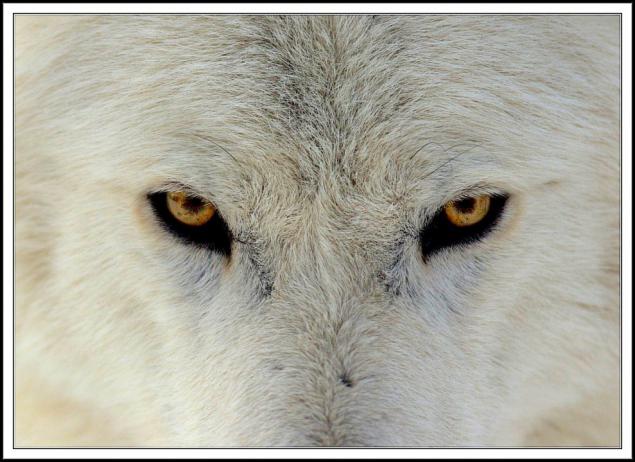
24. Colour polar wolf is well suited to its habitat: its skin merges with the white snow. This allows the wolf pack suddenly approaching its prey: it basically becomes large herbivores such as musk ox and elk.

25. In pursuit of herds of caribou and deer, wolves sometimes run more than 100 kilometers per day.

26. One wolf can eat per day to 10 kilograms of meat.

27. Arctic wolf is all that is necessary for the existence of the Arctic: a warm, do not miss the wind coat, sharp vision, the ability to hunt and a great sense of smell.

28. Pack of polar wolves are usually nomadic.

29. Polar wolf - one of the rarest animals on the planet. Hunting is prohibited on him because he is listed in the Red Book. However, it continues to destroy now.

30. Polar wolf - one of the favorite objects of art.

Source:
30 photo + letter via animalpicture
1. Polar Wolf lives in the vast expanses of the polar regions, which are five months immersed in darkness. To survive, the wolf has adapted any food that comes only. It is well-adapted to life in the Arctic could live for years in sub-zero temperatures for months without seeing the sunlight for weeks and go without food.

2. The length of an adult wolf - 100 - 150 cm, height at the withers - 65-80 cm, weight - 80 kg.

3. Polar wolves live up to seven years.

4. Polar wolves inhabit one of the most barren areas of the Earth, where in April the temperature rarely rises above -30 ° C. (~ Blickwinkel ~)

5. The most numerous group of animals living in these parts - it lemmings and Arctic hare. However, in order to survive, a pack of wolves is sometimes necessary, and larger prey. (conwest_john)

6. Such are musk oxen and reindeer, but they rarely come to these territories. Therefore, wolf pack should bypass an area covering 2,000 square kilometers. In winter the temperature drops. Small animals hide under the ground and caribou for food go to the south. Wolves follow them. (conwest_john)

7. At the open spaces of the tundra is difficult to find shelter for a surprise attack on the victim. (WhiteWolf35)

8. Polar wolves are kept in flocks of 7-10 individuals. The most common family pack, which consists of parents, their cubs and individuals from previous litters. (Kadacat (Marlene)

9. Pack, usually headed by the leader, and his female in the pack takes a similar position. The residue was subject to their flocks and forms its own hierarchy. (Anne Elliott)

10. The hierarchical relationships within the pack are carried out using complex language, consisting of movements, barking and growling. (conwest_john)

11. Wolves are holding a high position in the pack, subordinates require unquestioning obedience, they, in turn, expressing devotion humbly pressed to the ground or lie on your back. Severe, bloody clashes between wolves are rare. (Kadacat (Marlene)

12. Wolves howl to alert other flocks of his presence, so they mark territory and try to avoid the meeting, which would lead to a fight. (conwest_john)

13. Cry Wolf - is, as a rule, young animals, which have left their flock and went in search of a particular area. (conwest_john)

14. When a wolf is unoccupied territory it designates it by the urinary points or defecating in certain well-marked areas, stating your rights to it. (Michel Roy)

15. The period of mating polar wolves - from February to April. Gestation lasts 61 to 75 days. A young per litter is usually born 4-5. (alain tremblay)

16. In autumn and winter flock of migrating, but after the mating season, leaving her pregnant wolf to find a den. (conwest_john)

17. Sometimes, she digs wolf's den, but in winter, when the ground is frozen much, the female brings posterity in the old den in a rocky crevice or. (L. David Mech)

18. The cubs are born blind, with closed ear holes and absolutely helpless. They are totally dependent on the mother. (L. David Mech)

19. Approximately a month later the cubs already can eat half-digested meat, burp male who brings all this time the wolf cubs and food. If a lot of food, the young wolves from the beginning of the summer are full members of the flocks and migrate with adult individuals.

20. Only one in ten of the pack hunting is successful.

21. Sometimes the wolves for many days without food, but then eat 10 kg of meat at a time.

22. In the tundra so little food that the wolf, for example, eats arctic hare with skin, hair and bones.

23. Wolves are mostly nocturnal. They have developed excellent hearing.

24. Colour polar wolf is well suited to its habitat: its skin merges with the white snow. This allows the wolf pack suddenly approaching its prey: it basically becomes large herbivores such as musk ox and elk.

25. In pursuit of herds of caribou and deer, wolves sometimes run more than 100 kilometers per day.

26. One wolf can eat per day to 10 kilograms of meat.

27. Arctic wolf is all that is necessary for the existence of the Arctic: a warm, do not miss the wind coat, sharp vision, the ability to hunt and a great sense of smell.

28. Pack of polar wolves are usually nomadic.

29. Polar wolf - one of the rarest animals on the planet. Hunting is prohibited on him because he is listed in the Red Book. However, it continues to destroy now.

30. Polar wolf - one of the favorite objects of art.

Source:























